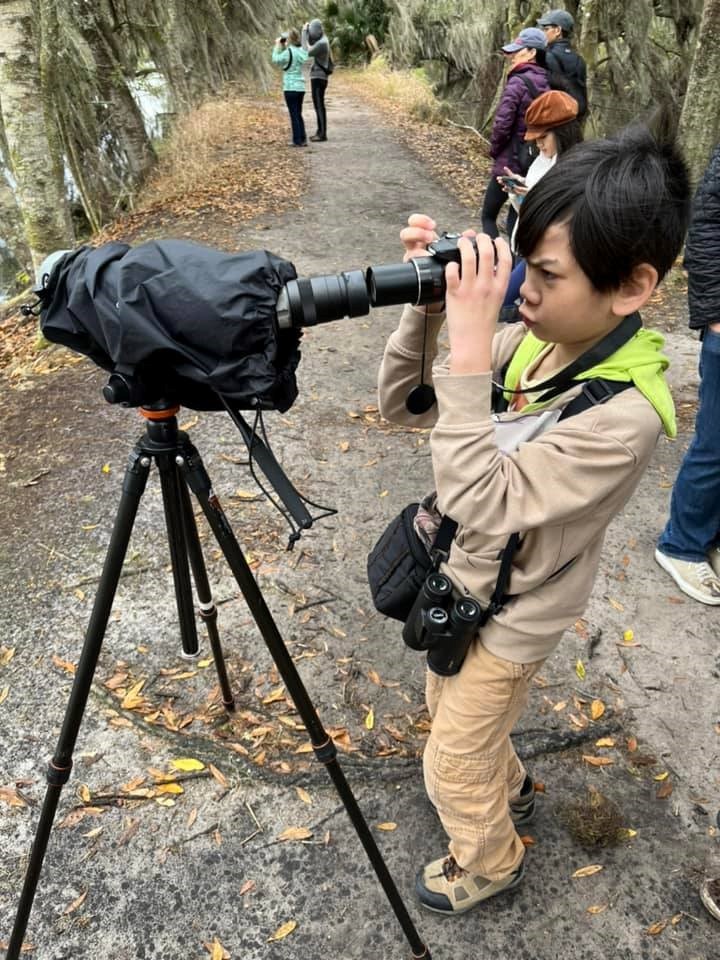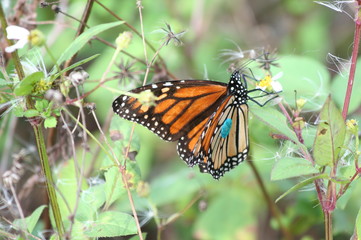 Barred Owl at Corkscrew Swamp Sanctuary.
Between Cape Coral and Naples lies a gateway to a forgotten world. Audubon's Corkscrew Swamp Sanctuary is home to North America’s largest old growth bald cypress forest, with trees estimated to be about 500 years old. More than 260 bird species have been recorded there, including resident Crested Caracaras and breeding Swallow-tailed Kites. A 2.25 mile long boardwalk provides easy access to this exceptional ecosystem, winding through the cypress forest as well as pine flatwoods, wet prairie and marsh before looping back to the visitor’s center. Purple Gallinules and an assortment of heron species dwell alongside the boardwalk in the swamp, and Barred Owls peer down at visitors from the trees. Keep an eye out for warblers, as more than 30 species have been recorded at the site. See Corkscrew Swamp’s boardwalk bird list for information on resident and visiting species and the best times to see them.
Corkscrew Swamp Sanctuary is also renowned as the home of the ‘super’ ghost orchid, so called because of its large size and prolific blooms. Ghost orchids, named for the trailing tendrils and white color of their five-inch flower, are found only in the wilds of Florida’s Collier and Hendy counties and in Cuba. Their limited range, remote habitat, and diminished numbers due to poaching, habitat loss and climate change mean few have had the privilege of seeing this endangered species. However, visitors to Corkscrew Swamp Sanctuary have been able to see the ‘super’ ghost orchid blooming every year since 2007. Viewing is done via scope or binoculars from the boardwalk, as the orchid is located fifty feet up an old growth cypress tree. The ability to see this particular orchid has proved invaluable to science. An award winning photograph of the plant disproved a long held assumption that the giant sphinx moth pollinates the ghost orchid, and a different image from the same study solved the botanical mystery by revealing the fig sphinx moth as the true pollinator.
Learn more about this amazing GFBWT Gateway site on the Great Florida Birding and Wildlife Trail website. If you’d like to visit, tickets can be purchased directly from Corkscrew Swamp Sanctuary.
 FYBC member on a birding trip.
The Florida Young Birders Club is a new club welcoming young birders (ages 9 - 17) from throughout the state of Florida. The club was initiated by Florida Avian Conservation and is sponsored by the Tampa, Orange and St. Johns County Audubon chapters and the Florida Ornithological Society. The goals of the club are to encourage, educate and empower youth conservation leaders, and bring young birders together to learn more about birds. There are currently three chapters, located in the Tampa, Orlando and St. Augustine areas, each offering a variety of programs. Learn more at their website and Facebook page.
 Tagged monarch butterfly at St. Marks National Wildlife Refuge.
Like the migration itself, the annual Monarch Festival at St. Marks National Wildlife Refuge each October is one of the most anticipated events of the year. The refuge is a major stop for eastern migratory monarchs heading to Mexico, and a hotspot for wildlife viewers who want to encounter them. The night before the festival, FWC scientists are hard at work collecting sleeping butterflies to be tagged and released the next day during the festivities. Tagging the butterflies helps scientists know where and how far they travel, essential information for conservation efforts. In July 2022 migratory monarchs were identified as being at high risk of extinction by the International Union for the Conservation of Nature (IUCN) after suffering severe population declines over the last decade. The declines are driven by habitat loss for agriculture and development, pesticide use that kills both the monarchs and the milkweed plants their caterpillars need to survive, and climate change intensifying risks from drought, storms and wildfires.
North America has two populations of migratory monarch butterflies separated by the Rocky Mountains, and both travel south for the winter from September to early November. The western population winters in California while the eastern population (including some of Florida’s monarchs) can travel as far as Mexico. These butterflies are born in their northern territories and journey to a land they have never seen before using a mix of navigational techniques, including genetic cues and tracking the position of the sun.
The eastern monarchs reach Mexico near the end of October during Día de los Muertos, a celebration with indigenous roots when Mexicans honor the souls of their departed loved ones, symbolized by the returning butterflies. They spend the winter sleeping clustered together in Oyamel fir trees high in the mountains. These trees keep them dry and warm until spring, when they begin the long journey back to the USA. However, by this point they are nearing the end of their nine-month lifespan. The journey back is like a relay race. They run the first leg, laying eggs as they travel north and passing the baton on to the next generation. Their offspring do the same for the second leg of the trip, and it is the third generation that ultimately returns to the northern territory of their ancestors. These northbound butterflies live a mere two to six weeks. The fourth and longest-lived generation will make the next southern migration and are the great-grandchildren of the last butterflies to do so.
Spanning up to 3,000 miles, the intergenerational journey of these delicate-seeming insects is one of the most inspiring migrations on the planet. We have the power to ensure that it continues by creating monarch habitat in and around our homes. Growing a diverse range of flowering plants helps support adult monarchs, and planting pesticide-free native milkweed around our homes and in our gardens provides vital food for monarch caterpillars as the butterflies cross the continent. Many garden centers carry both native and non-native milkweed varieties, so be sure to ask about the right kind for your area. Learn more about native milkweed here.
|